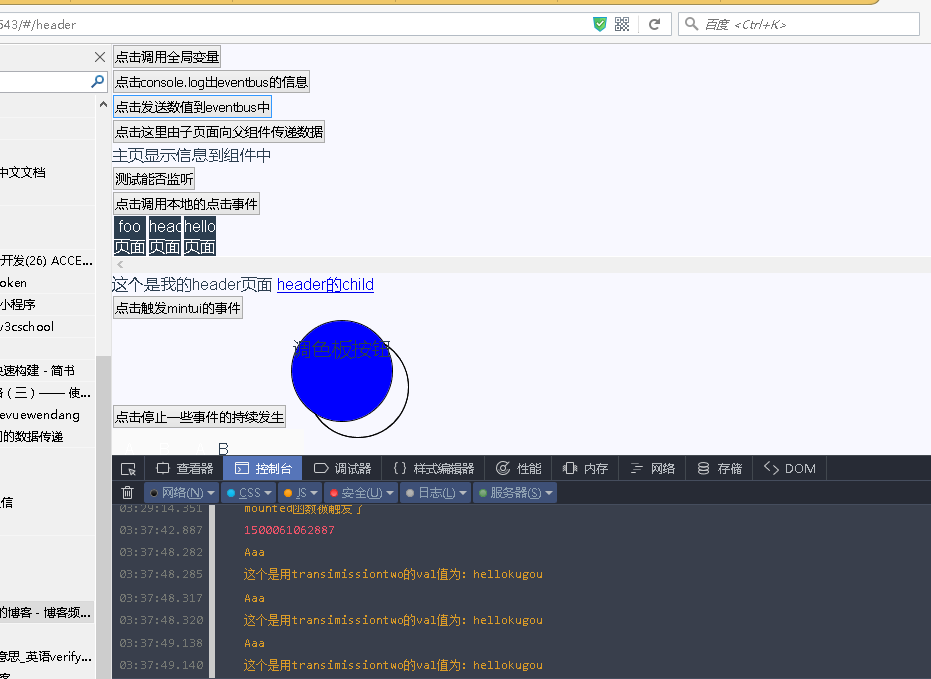的我们而言,并非是只有写界面才是最大的问题,很多的情况下,我们需要关注的是数据,比如js页面的数据传递等等,学习vue我们也是需要知道怎么去使用数据
当然,使用存储也是可以得,但是并非一定要缓存,当然在vue中有推荐了我们去使用vuex去数据交互,Vuex会让你的Vue代码足够灵活可控,把数据统一存入state, 只允许通过Actions触发Mutations修改。然而,有时候我们的项目并没有复杂到需要用上Vuex。,(我们也不讨论已经废除的vm.$dispatch)很多情况下我们都是需要一个事件的捕获,这时候我们就可以用到vue的eventbus了
受用eventbus的方法很是简单,我们需要做三步事情,第一步,我们需要创造一个容器去充当我们的eventbus
第二步,我们需要去抛出,或者说提交我们的事件
第三步,我们去监听我们的那个事件(也许这才是第二部)
首先,我们需要在全局定义我们的eventbus
这里我们定义到了eventbus。这就简单的完成了我们的第一步,当然,全局变量,我想你应该知道定义在哪儿的
接着我们先去抛出这个事件,使用¥。emit去“提交”
怎样,这点都可以理解吧,其次我们经行第三步,去监听
当然。这里已经监听好的。点击事件俺只是个累赘,
接下来我们就要去界面中使用它们了
首先,倒入我们所需要的文件:

这里我使用的是谈transimissionone还有transimissiontwo两个文件‘
接着是定义
其次是使用
最后运行我们的项目,查看下效果
这边主要是交大家使用,所以代码就俘虏在下面,主要是四个文件
transimissionone。vue(发送事件的文件)
<template>
<div class="transimission1">
<button @click="get">点击发送数值到eventbus中</button>
</div>
</template>
<script>
export default {
name: "transimission1",
methods: {
get: function() {
console.log("Aaa");
eventBus.$emit('eventBusName', "hellokugou");
}
},
}
</script>
<style>
</style>其次是transimissiontwo(监听者)
<template>
<div class="transimissiontwo">
<button @click="method1">点击console.log出eventbus的信息
</button>
</div>
</template>
<script>
export default {
name: "transimissiontwo",
methods: {
method1: function() {
//使用on老监听事件
eventBus.$on('eventBusName', function(val) {
console.log("这个是用transimissiontwo的val值为:"+val)
})
}
}
}
</script>
<style>
</style>接着是我们的中枢。app。vue中使用
<template>
<div id="app">
<click></click>
<transimissiontwo></transimissiontwo>
<transimissionone></transimissionone>
<sendparent @listenertochildevent="getmessagefromchild"></sendparent>
<value :locallogo="netlogo"></value>
<!--无法监听,说明要在那个组件中-->
<button @listenertochildevent="getmessagefromchild">测试能否监听</button>
<my_plug_in></my_plug_in>
<div class="choose_div">
<ul>
<li>
<router-link to="/foo">foo页面</router-link>
</li>
<li>
<router-link to="/header">header页面</router-link>
</li>
<li>
<router-link to="/hello">hello页面</router-link>
</li>
<li style="clear: both;list-style: none;"></li>
</ul>
</div>
<div class="main">
<router-view class="my_router_iew"></router-view>
</div>
<testmintui></testmintui>
</div>
</template>
<script>
import value from './components/value'
import click from "./components/click"
import my_plug_in from "./components/plug_in"
import sendparent from "./components/send_parent"
import testmintui from "./components/Test_mint-ui"
import transimissiontwo from "./components/transimissiontwo"
import transimissionone from "./components/transimissionone"
export default {
name: 'app',
data() {
return {
netlogo: "主页显示信息到组件中"
}
},
components: {
value,
click,
my_plug_in,
sendparent,
testmintui,
transimissionone,
transimissiontwo,
},
methods: {
getmessagefromchild: function(data) {
console.log(data);
}
}
}
</script>
<style>
body {
background-color: #f8f8ff;
font-family: 'Avenir', Helvetica, Arial, sans-serif;
color: #2c3e50;
}
ul {
width: 12rem;
}
ul li {
list-style: none;
}
ul li:not(:last-child) {
list-style: none;
width: 2rem;
margin-left: 0.1rem;
margin-right: 0.1rem;
float: left;
text-align: center;
background: #2C3E50;
color: white;
}
ul li a {
text-decoration: none;
font-size: 16px;
color: white;
line-height: 1rem;
text-align: center;
}
ul li:nth-child {
list-style: none;
clear: both;
}
.choose_div {
width: 100%;
overflow: scroll;
}
</style>请无视掉没用的代码。接着就是定义eventbus了
window.eventBus = new Vue();就这样,很是简单,当然,对于级别的可以使用prop,下回再讲





